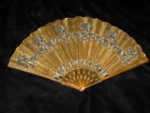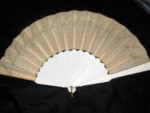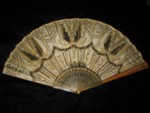Click on the image for details!

fig.1 Small
spangled fan, approx. 1805, France?

fig. 3 Empire-Pastiche,
approx. 1880, Austria ?
Spangled Fans
European fan makers adapted their products according to fashion and the taste of the period ("Zeitgeist"). This is reflected in fan motives, size, material and decoration. Very early fans are decorated with straw (approx. 1620, see E.Tayler/A. Hart, Biblio. No 2). Later on, straw was applied as decorating accent on leaves and sticks. The french word "paillette" for sequins stems from the French word for straw, paille. Louis XVI fans show sequins as decoration around vignettes or at the border of the fan. Towards the end of the 18th century, the straw fashion became evident, as Monsieur Peltier writes in his book "Paris" in 1799 (quoted in Blondel. 1875, Biblio No. 85): Everybody wore straw: straw hats, straw ribbons, even straw fans. However, the caricaturistic period poem refers to "sequins" when it talks about "paillette".
It should be noted that the English word "sequin" for round metal discs stems from the Italian "zechino", the smallest piece of money. Allegedly, an Italian woman (maybe Venetian) of the Cinquecento (16th century) had her worthless "zechini" pierced and sewn on her dress. Other than round sequins are called spangles.
After the French Revolution fans became simpler, around 1800 also considerably smaller. The French Empire period (1799-1814) sees the fan fitting in style and decoration to the Greek-influenced fashion (floating fabrics with high waist line). Fan leaves consisted of silk, gauze or (metal) mesh, decorated with sequins and spangles in geometric or floral patterns (see fig.1).
The "Second Empire" (1852-1870) sees a revival of the Empire fashion that is reflected in geometric simplicity (fig.3). Another example is fig.2, that displays a central vignette etched by Pomel, surrounded by sequins that also decorate the rest of the leaves in ornaments.

fig. 2 "Second
Empire" fan, approx. 1860(?), France?

fig. 4 Empire
1810 or Pastiche Empire 1900?, France ?